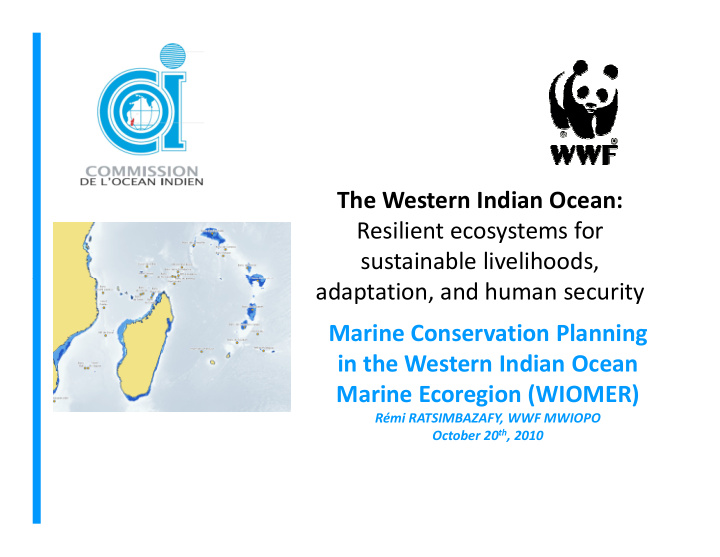



The Western Indian Ocean: Resilient ecosystems for sustainable livelihoods, adaptation, and human security adaptation, and human security Marine Conservation Planning in the Western Indian Ocean Marine Ecoregion (WIOMER) Rémi RATSIMBAZAFY, WWF MWIOPO October 20 th , 2010
Institutional Background � “Marine Protected Area Network Project”: a Programme of the Indian Ocean Commission, implemented by WWF Madagascar & West Indian Ocean Programme Office (WWF MWIOPO). � Financial Partners: Fonds Français pour l’Environnement Mondial (FFEM), WWF, Ministry of Foreign Affairs of France, Mondial (FFEM), WWF, Ministry of Foreign Affairs of France, Conservation International. � Participant Countries: Comoros, France/Reunion, Madagascar, Mauritius and Seychelles. � Project Duration: March 2006 – December 2010. � Objective: sustain marine and coastal biodiversity and resources through the creation of a coherent MPA network. 1
Marine Conservation Planning � Representation of habitat and species range: how much should be protected to ensure viability? � Persistence of biodiversity: select ecological processes and functionality, select sites for resilience to climate change. � Combining modelling tools and expert knowledge. � Combining modelling tools and expert knowledge. � Modelling tools which provide quantitative and objective information. � Allows better involvement of stakeholders and better quality of the data input. � Outcomes: identify a network of seascapes and sites of significant importance for biodiversity and fisheries conservation. 2
Process Adopted � Georeferenced data collection of environmental, biological and ecological features at regional scale. � Two expert and stakeholder workshops were organized to identify the regional focal species and identify priority areas based on criteria used by the Convention for Biological Diversity. Diversity. � Identification, quantification and mapping of marine ecosystems Drivers of Change based on anthropogenic threats. � Identification of 05 subunits based on biophysical data through clustering analysis process (GDM). � Marxan analysis which helped the experts in identifying priority seascape areas and sites of special significance using targets of 30% for marine habitats. 3
4
5
Proposed Regional Strategy for Marine Ecosystems & Fisheries � A VISION for biodiversity & fisheries. � 49 priority Seascapes & Sites of global, regional and national significance. � 07 key regional initiatives related to artisanal � 07 key regional initiatives related to artisanal fisheries and offshore fisheries ; network of MPA; Wide-ranging species & species of special concern; Oil & gas development; Adapting marine protected areas and fisheries to CC; Critical gaps in knowledge for effective management. 6
Next Steps… � Supporting the development of WIOMER strategy DRAFT DOCUMENT through intensive DOCUMENT through intensive consultation process towards government institutions and scientific communities. 7
Outstanding Values � WIOMER is a World Class Marine Ecoregion. � Different types of islands with diverse tropical marine habitats supporting a wealth of marine biodiversity, many of which are found nowhere else. � One of the world’s largest seagrass beds and reef banks (Mascarene Plateau). � Oceanic islands with a granitic continental core that are fringed with an ancient and distinctive reef fauna. � A global hotspot for coral reef fish and invertebrates endemism, with a particularly foci of local endemism in the endemism, with a particularly foci of local endemism in the Mascarenes. � Some of the healthiest populations of blue, humpback, and sperm whales. � Globally outstanding aggregations of seabirds and marine turtles on feeding grounds and islands. � An extraordinarily productive seamount (north of the Seychelles). � A relatively intact population and migration of catadromous eels. 8 � Population of dugong and famous cœlacanth.
Recommend
More recommend